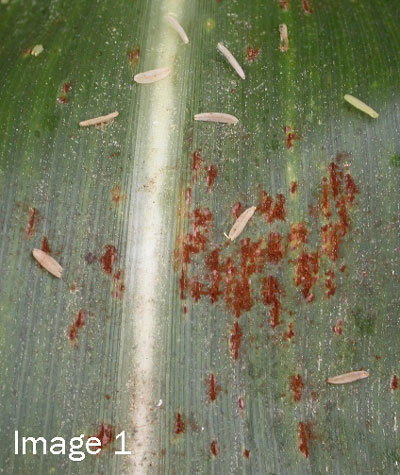
- Common rust and southern rust are two diseases attacking corn in our area.
- The two rust diseases have significant differences.
- Fungicide application is rarely advised for rust infections, but may be under some conditions.
Introduction
Two rust diseases affect corn in our area, common rust (Puccinia sorghi) and southern rust (Puccinia polysora). Common rust, as the name implies, is a somewhat "common" pathogen of corn. Signs and symptoms of this disease are often noted on corn in the early part of the growing season. Southern rust tends to arrive later in the growing season and signs and symptoms may be noted on corn leaf tissue very late in the season. Both rust diseases do not overwinter in our area, but spores blow up from Mexico and the southern U.S. in the spring and summer. Following is a comparison of these two diseases, with information on diagnosis and management:
Diagnosing Rust Diseases in Corn
Common rust may be distinguished from southern rust in several ways:
- Where – Common rust pustules are typically visible on both upper and lower leaf surfaces. The pustules often occur in loose bands across leaves resulting from daily peak spore germination while the leaves are still rolled in the whorl. Common rust pustules will rarely colonize leaf sheaths. Southern rust pustules are more numerous and concentrated on upper leaf surfaces, and may also be more commonly found on leaf sheaths, husks and stalks. On susceptible corn hybrids, southern rust pustules may nearly cover a number of leaves on the plant.
- When – Common rust infection is favored at temperatures between 60 and 74 degrees Fahrenheit and high humidity or rainfall. Infection and disease development slow greatly when temperatures exceed 80 degrees. Southern rust infection increases at temperatures between 77 and 82 degrees. Although southern rust requires moisture for leaf infection, it is capable of infecting corn during normal summer weather. Morning dew may provide adequate moisture for spore germination. Southern rust usually shows up after corn begins silking.
- Pustule Appearance – Common rust pustules are typically elongate and rupture readily to release spores. Southern rust pustules tend to be more round in shape, are often smaller, and are slower to rupture. Southern rust pustules are often observed with the epidermis still intact.
- Spore Appearance – Spores of common rust are usually described as being brick red to cinnamon-colored, while spores of southern rust are yellow orange to tan in color. CAUTION: Late in the growing season, spores of both rust diseases may be black and pustule appearance may also change.
Yield Loss and Management
Common rust is generally believed to cause little corn yield loss in field corn in our area but may be damaging in sweet corn and some seed corn inbreds. Most commercial field corn hybrids have some level of resistance to rust. Some specialists believe that common rust may predispose the corn plant to infection by other pathogens, like gray leaf spot. In rare situations, when common rust seems to be threatening corn yields, most labeled foliar fungicides should provide a moderate level of control of the disease.
Southern rust generally arrives too late in the growing season to severely affect corn yields. As with common rust, some experts believe that southern rust may have an additive or synergistic effect with other corn diseases, like stalk rots. The late arrival of this disease also means that timely fungicide application is often impractical. Here are some guidelines for fungicide application, modified from Texas A & M University information:
| Vegetative Growth Stages | Southern rust infection is unlikely |
| VT (Tassel) to R3 (Milk) | Fungicide application should offer value |
| R4 (Dough) | With high disease pressure, fungicide application may provide economic return |
| R5 (Dent) and Later | Do not apply fungicides |

Contact your FS Crop Specialist for your agronomic information.
Image 1: band of common rust pustules on corn leaf
Image 2: Southern rust pustules on corn upper leaf surface